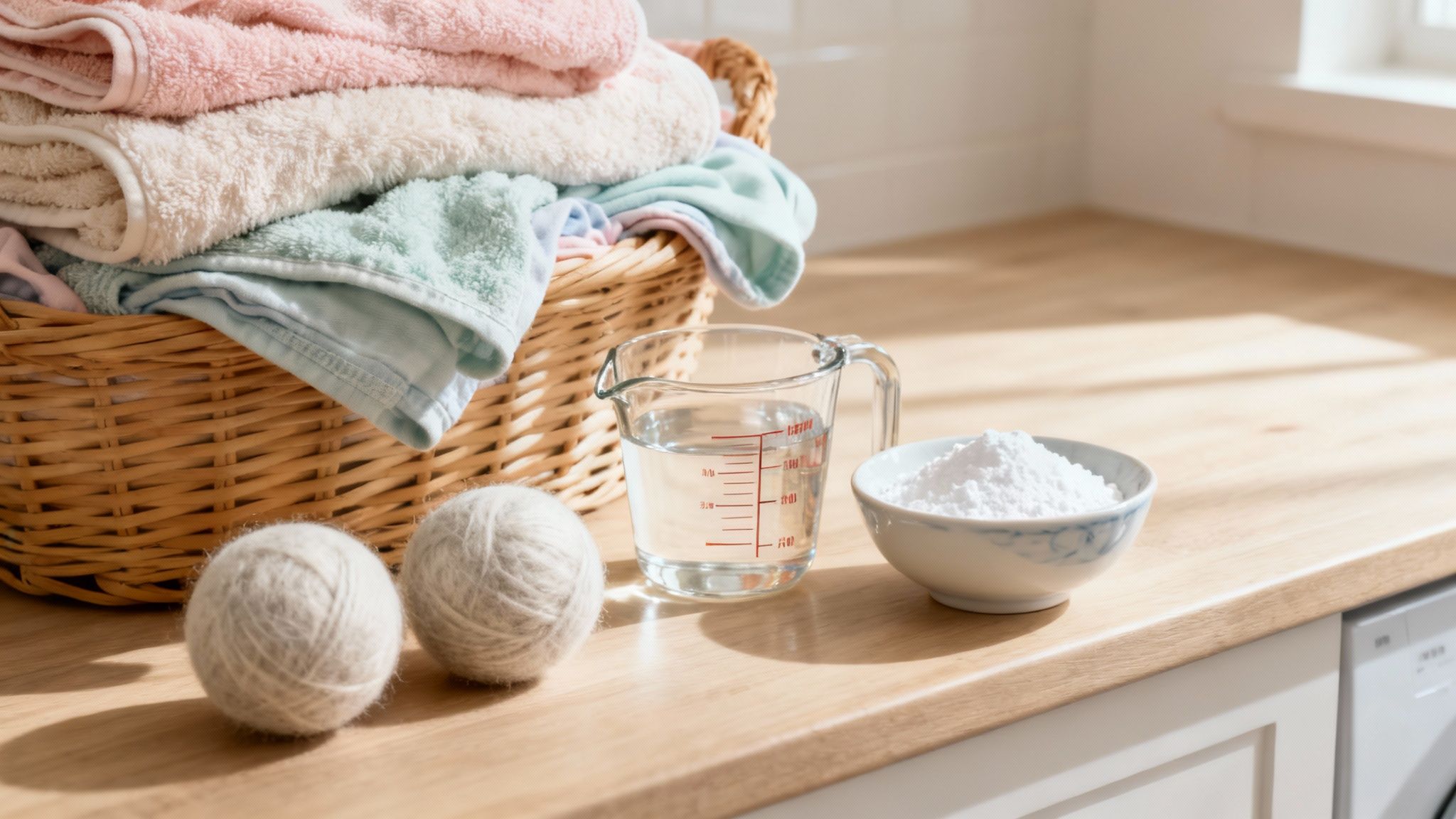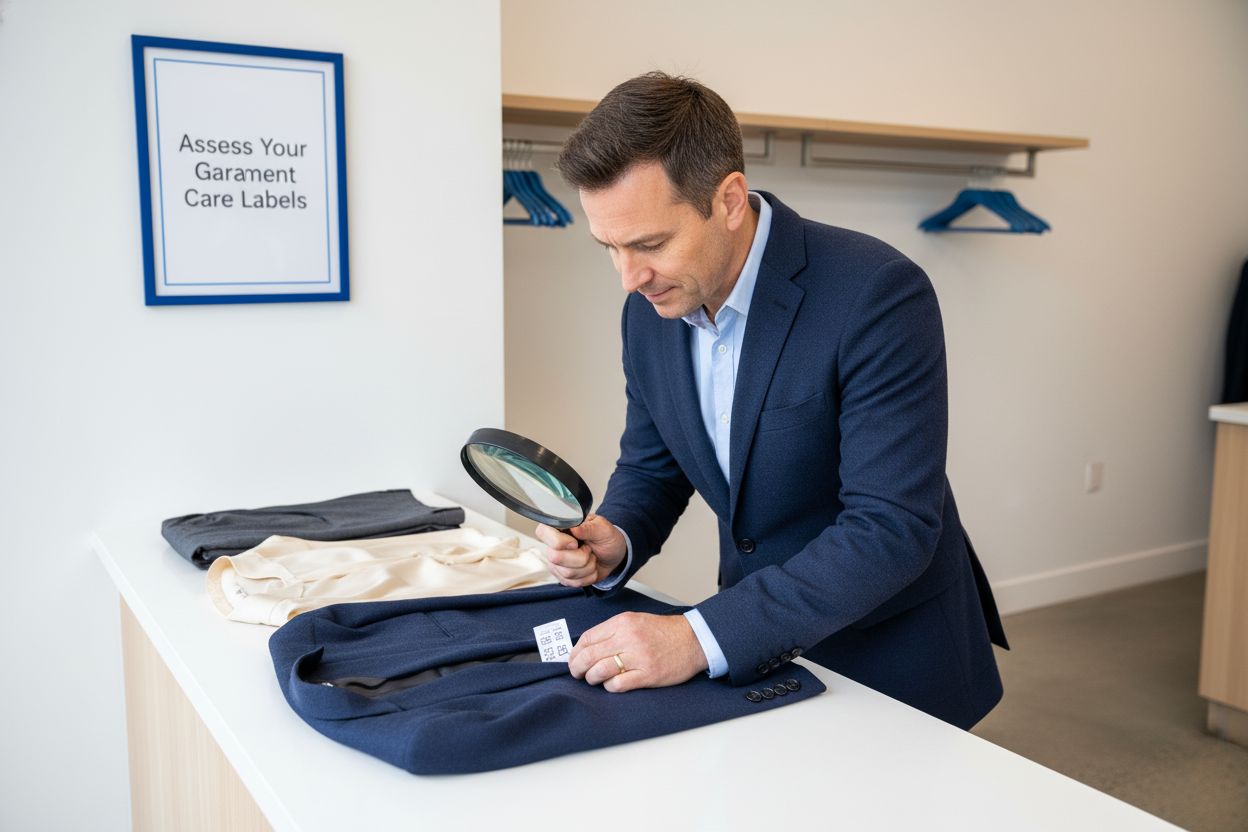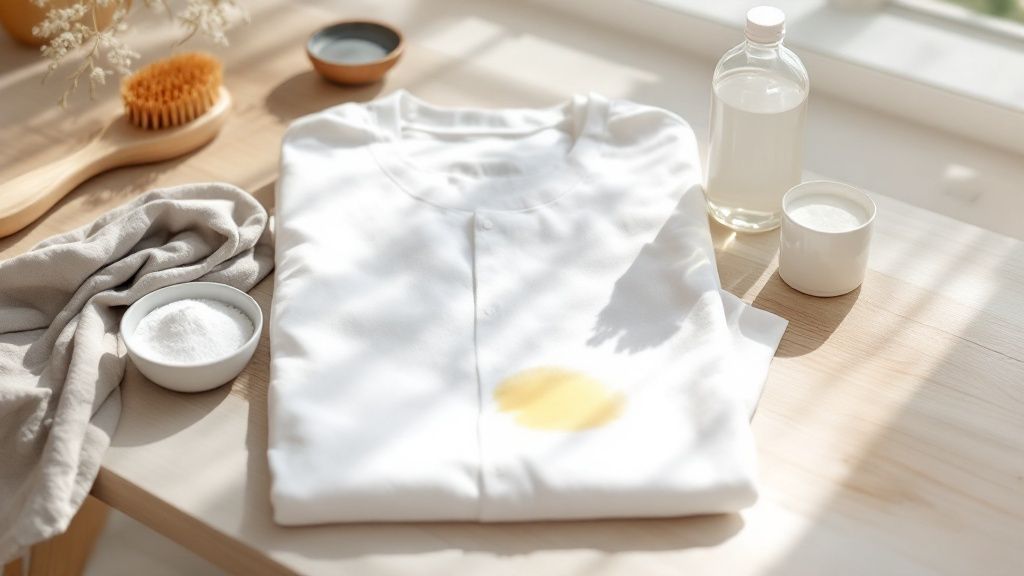How to Soften Fabrics: Quick Tips (how to soften fabrics)

The fastest way to soften up your clothes is to go after the two biggest culprits of stiffness: detergent residue and hard water minerals. Seriously, just using a little less detergent and adding a half-cup of white vinegar to the rinse cycle can make a world of difference.
Why Your Laundry Feels Stiff (And How to Fix It)

Have you ever pulled a favorite t-shirt or a fluffy towel from the dryer, only to find it feels like cardboard? It’s a super common laundry headache, and it usually boils down to a few simple things that build up over time. Once you know what's going on, you're on the path to getting that soft, cozy feel back.
The Science of Stiff Fabrics
When you get down to the microscopic level, fabric stiffness is what happens when the individual fibers get coated or become rigid. They can't move freely against each other anymore, which gives you that rough, unyielding texture.
There are a few usual suspects for this:
- Detergent Buildup: This is a big one. Using too much soap is probably the number one reason for stiff clothes. The excess detergent doesn't get a chance to rinse out completely, leaving behind a film that stiffens everything up.
- Hard Water Minerals: If your water has a high concentration of minerals like calcium and magnesium, they can deposit right onto your clothes. This makes them feel rigid and can even make colors look dull.
- Over-Drying: Blasting your laundry with too much heat for too long essentially "bakes" the stiffness into the fabrics. This is especially true for natural fibers like cotton, leaving them brittle and scratchy.
Tackling stiffness isn't just about pouring in more softener; it's about removing what’s making the fabric rigid in the first place. A simple tweak to your routine can have a huge impact.
If you’ve tried everything and your laundry is still coming out stiff, the problem might actually be your dryer's performance. It’s a good idea to check for common dryer vent clogged symptoms, because poor airflow can mess with drying efficiency and make fabrics feel rough.
It's clear people are looking for solutions. The global fabric softener market is expected to jump from $24.8 billion in 2025 to nearly $43.8 billion by 2035. That kind of growth shows just how much we all care about getting softer, better-cared-for clothes.
Soften Clothes Naturally with Kitchen Staples

You don’t need a shelf full of chemical-laden products to get that wonderfully soft laundry feel. Believe it or not, the secret to softer, fresher clothes might already be sitting in your kitchen pantry. These simple, budget-friendly staples are powerhouse cleaners and softeners, working to remove the very things that make fabrics feel stiff in the first place.
Instead of just masking stiffness with waxy coatings like some commercial softeners do, these natural alternatives get to the root of the problem. They gently dissolve mineral deposits from hard water and strip away stubborn detergent residue. This allows the fabric fibers to finally relax and return to their natural, comfortable state.
Harness the Power of Distilled White Vinegar
Think of distilled white vinegar as a reset button for your laundry. Its mild acidity is perfect for breaking down the alkaline mineral and soap buildup that clings to fabrics, leaving them rough and scratchy. And don't worry about the smell—it rinses away completely, taking any lingering musty odors right along with it.
For a standard load, just pour a half-cup of distilled white vinegar into your washing machine's fabric softener dispenser. It gets released during the final rinse cycle, working its magic to clarify and soften everything just before the wash is done. This one simple step can dramatically improve the texture of everything from your favorite cotton t-shirts to your bed linens.
Boost Your Wash with Baking Soda
Baking soda is another hero from your kitchen that truly excels in the laundry room. It acts as a natural water softener, which helps your detergent clean more effectively while preventing new mineral deposits from clinging to your clothes. It’s also a fantastic deodorizer.
Just add a half-cup of baking soda directly into the drum with your clothes right at the start of the wash cycle. As it dissolves, it helps regulate the water's pH level, leading to a much cleaner rinse and noticeably softer results. You can dive deeper into this dynamic duo by reading our guide on washing clothes with baking soda and vinegar.
Pro Tip: While both are excellent softeners, don't use vinegar and baking soda in the wash cycle at the same time. They'll just neutralize each other, canceling out their benefits. For the ultimate softening combination, use baking soda at the start and save the vinegar for the rinse.
For a quick overview of how these kitchen staples stack up, here’s a simple comparison.
Natural Fabric Softening Alternatives
These simple additions can make a huge difference in how your laundry feels, all without the synthetic chemicals found in many store-bought options.
Revive Rough Towels with an Epsom Salt Soak
Have your bath towels become disappointingly scratchy and lost their absorbency? An Epsom salt soak can bring them back to life. Epsom salt is fantastic at stripping away the waxy buildup from commercial fabric softeners that often plagues towels.
To give your towels a deep-softening treatment:
- First, fill a bathtub or a large basin with warm water.
- Dissolve one cup of Epsom salt completely in the water.
- Submerge your stiff towels and let them soak for several hours, or even overnight.
- After they've soaked, wring them out and run them through a regular wash cycle without any detergent. This final rinse washes away the loosened residue and salt, revealing much softer, more absorbent towels.
Switch to Wool Dryer Balls
Wool dryer balls are a fantastic, reusable alternative to single-use dryer sheets and a game-changer for naturally softening clothes. They work by physically tumbling between your clothes, separating items to allow for better air circulation. This not only fluffs up the fibers but can also reduce your drying time by up to 25%.
They are made from 100% natural wool, which makes them hypoallergenic and completely free of the chemicals and artificial fragrances found in most dryer sheets. Just toss three to six balls into the dryer with your wet laundry and let them do their thing. A single set can last for over 1,000 loads, making them an incredibly eco-friendly and cost-effective choice for any household.
Get Softer Clothes Straight From Your Washing Machine

The real secret to softer fabrics isn't always about what you pour into the machine. It’s often about how you use the machine itself. Your washer is a powerful tool, and with a few simple adjustments, you can turn your regular wash cycle into a masterclass in fabric softening. You’ll get clothes that feel supple and truly clean, not stiff and scratchy.
We’ve all been there—cramming the washer to the absolute brim to get the chore done in one go. But an overloaded drum is one of the biggest culprits behind stiff, crunchy laundry. When clothes are packed in too tightly, water and detergent can't circulate properly. This leads to a shoddy rinse cycle that leaves behind a film of stiffening residue.
Here's a pro tip: a properly loaded washer should only be about three-quarters full. That’s the sweet spot. It gives your laundry enough room to tumble and agitate, ensuring every single item gets thoroughly washed and, more importantly, completely rinsed.
Fine-Tuning Your Washer's Settings
Beyond just how much you load, the settings you choose make a massive difference. You can dramatically improve the texture of your fabrics by making a few intentional tweaks—no extra products needed.
Try making these small but mighty adjustments to your routine:
- Add an Extra Rinse. If your machine has this option, use it. This is probably the single most effective way to fight stiffness, as it ensures every last bit of detergent residue is washed away.
- Pick the Right Water Temp. Cold water is fantastic for protecting colors and delicate fibers, but it sometimes struggles to dissolve powdered detergents fully. If you're a fan of powder, warm water is usually a better bet for a residue-free clean. Liquid detergents, on the other hand, tend to dissolve just fine at any temperature.
- Don't Go Overboard on Detergent. More soap does not mean cleaner clothes. It just means a higher chance of leaving behind that stiffening film. Stick to the measurement lines on the cap—they're there for a reason.
As washing machines became household staples worldwide, the need for better laundry techniques grew. For instance, as China’s household appliance exports jumped 20.8% in just one year, the demand for softeners also climbed. This is partly because modern, efficient machines can contribute to stiffness if they aren't used correctly. You can learn more about global fabric care market trends to see how this plays out on a larger scale.
A Quick Word on Commercial Softeners
While our goal is often to reduce buildup, commercial softeners definitely have their place when used correctly. Understanding what fabric softener is used for can help you decide if it’s the right move for a particular load. Essentially, they work by coating fibers with a lubricating film that makes them feel smoother to the touch.
The key is to use them sparingly. This is especially true for absorbent items like towels, where that coating can build up over time and actually reduce their fluffiness and effectiveness.
By first optimizing your washer settings, you can often get that incredible softness you're after with less reliance on added products. It's a win-win for your clothes and your machine.
How to Soften Different Types of Fabric

You can't treat all fabrics the same and expect them to feel soft. The secret to that ahh-inducing texture is knowing that every material in your laundry basket needs its own kind of TLC. A rugged bath towel requires a completely different approach than a delicate silk blouse, and using the wrong method can do more harm than good.
Get it right, though, and you can bring a garment back to life and keep it feeling great for years. Let's break down the best strategies for the most common fabrics you're dealing with.
Caring for Cotton and Towels
Cotton is a workhorse fabric, but all that durability comes with a downside: it gets stiff. Detergent residue and minerals from hard water are the usual culprits. This is especially noticeable with towels, which can go from fluffy and absorbent to scratchy and sad in just a few washes.
The fix is surprisingly simple, and it's probably already in your pantry. Forget the waxy commercial softeners for a bit. Instead, run a wash cycle with one cup of distilled white vinegar added to the fabric softener dispenser. This trick works wonders by dissolving all that stiffening buildup without leaving a new coating behind, letting the natural softness of the cotton fibers shine through.
Taming Synthetics Like Polyester
Polyester and nylon are famous for their toughness, but they're also notorious for static cling. These fabrics don't hold onto moisture well, which creates the perfect storm for static electricity, especially in the dry heat of a clothes dryer.
Your best bet here is to add a physical buffer that improves airflow. I'm talking about wool dryer balls.
They’re a fantastic, natural solution.
- How They Work: As they bounce around in the dryer, they physically separate your clothes, letting hot air circulate more efficiently. This not only cuts down on drying time but also softens the fabric by gently beating against the fibers.
- Static Reduction: For a little extra static-fighting power, run one or two dryer balls under the tap to get them slightly damp before tossing them in. That little bit of humidity helps neutralize static before it can build up.
Of course, dryer sheets are another popular option, often because people love the scent. Fragranced sheets actually held a 70% revenue share in the market recently. But unscented options are gaining ground as more of us become mindful of skin sensitivities and environmental impact.
Handling Wool, Silk, and Other Delicates
Natural fibers like wool and silk are in a league of their own and demand a much gentler approach. High heat and rough agitation will cause them to shrink, warp, or become permanently stiff. Because they have a protein-based structure, they respond incredibly well to simple, conditioning treatments.
Ever had a wool sweater lose its supple feel? Or a silk scarf that feels a bit rigid? A quick soak with hair conditioner can work miracles. Seriously.
Fill a small basin with cool water and stir in a tablespoon of a gentle hair conditioner. Let the garment soak for about 30 minutes, then gently rinse it with cool, clean water—no wringing! To dry, lay it flat on a fresh towel, away from any direct heat or sunlight.
This method conditions the fibers just like it does your hair, leaving them feeling silky and brand new. Understanding these nuances is key, especially for sensitive items like baby clothes; a good guide to fabrics for newborn clothes can be a lifesaver for new parents.
Keep Your Fabrics Softer for Longer
There's nothing quite like pulling a perfectly soft load of laundry from the dryer. But how do you keep it that way? The real secret isn't fixing stiff, scratchy fabrics after the fact—it's preventing them from getting that way in the first place. A few simple, consistent habits can preserve that wonderful texture for the long haul.
It actually starts before your clothes even hit the water. Most of us are trained to sort laundry by color, but sorting by fabric weight is a game-changer for softness. Tossing heavy denim and thick towels in with your lightweight t-shirts is a recipe for disaster. The lighter items get pummeled in the wash, leading to pilling and fiber damage that makes them feel rough over time.
Smart Drying Habits Make a Difference
Your dryer can be your best friend or your worst enemy when it comes to keeping things soft. The single biggest mistake? Over-drying. Blasting your clothes on high heat for too long essentially bakes the fibers, leaving them brittle, stiff, and lifeless.
Instead, try making these small adjustments to your drying routine:
- Turn Down the Heat: Unless you're drying a load of heavy towels, a medium or even low heat setting is almost always enough. It’s much gentler on the fabric, helping it retain a bit of its natural moisture.
- Don't Cram the Dryer: Just like in the wash, your clothes need room to tumble freely. An overstuffed dryer traps steam and leads to uneven drying, which is a one-way ticket to stiffness.
- Give Line-Drying a Shot: When you have the time and space, air-drying is the absolute best way to preserve fabric softness and extend the life of your clothes. If you find your line-dried items feel a little crisp, just toss them in the dryer on a no-heat "air fluff" cycle for ten minutes with a couple of wool dryer balls. They’ll soften right up.
The goal isn't bone-dry laundry; it's perfectly-dry laundry. Pulling clothes from the dryer while they are still the slightest bit damp prevents the fibers from becoming rigid and over-stressed from excessive heat exposure.
Preventing Hard Water Havoc
If you live in an area with hard water, you’re fighting an invisible battle against mineral deposits like calcium and magnesium. These minerals love to cling to fabric fibers, creating a stiff, dull coating that just builds up with every single wash.
Thankfully, the fix is simple. Consistently add a water-softening agent to your wash cycle. A half-cup of baking soda or borax tossed directly into the drum along with your detergent helps neutralize these minerals. This allows your detergent to work more effectively and stops that dreaded mineral buildup before it even starts.
It's a small step, but it makes a huge difference in how your laundry feels long-term. And once your clothes are perfectly clean and soft, learning about the art of storing clothes properly is the final piece of the puzzle to keep them that way.
Common Questions About Softening Fabrics
Even when you follow all the right steps, laundry can still throw you a curveball. If you’ve ever found yourself wondering if you can mix certain household softeners or why your towels still feel like sandpaper, you’re definitely not alone. Let's clear up some of the most common questions that pop up when you're trying to master the art of soft fabrics at home.
Can I Use Vinegar and Baking Soda in the Same Wash?
This is a fantastic question, and the answer is all about timing. You absolutely should avoid adding them at the same time. When mixed directly, they just neutralize each other, and all their amazing softening and cleaning powers fizzle out before they can do any good.
The trick is to use them separately within the same wash cycle. Start by tossing a half-cup of baking soda right into the drum with your clothes. Then, pour a half-cup of white vinegar into the fabric softener dispenser. This way, the vinegar gets released during the final rinse cycle to wash away any lingering residue.
Will Vinegar Make My Clothes Smell Bad?
It’s a totally valid concern—vinegar has a pretty potent smell right out of the bottle. But the short answer is no, your clothes won't smell like a salad.
That strong scent rinses away completely during the wash. In fact, vinegar does the exact opposite of leaving a smell behind; it actually pulls out musty odors and trapped bacteria from the fibers. Your laundry will come out smelling perfectly fresh and neutral.
The secret is in the acidity. Vinegar's acidic nature is what makes it so good at breaking down the mineral and soap residues that trap bad smells in fabric.
Why Are My Towels Still Scratchy After Using Fabric Softener?
Ah, the classic case of too much of a good thing. Most commercial fabric softeners work by coating fibers in a waxy, lubricating film. While it feels soft at first, that coating builds up over time, destroying the towel's absorbency and, ironically, making it feel stiff and rough.
To fix this, you need to strip that residue away. Run your towels through a hot wash cycle with one cup of white vinegar and no detergent. Follow that up with a second hot cycle using just a half-cup of baking soda. This one-two punch breaks down the buildup and brings back their natural, fluffy softness.
Are Wool Dryer Balls Better Than Dryer Sheets?
If you’re aiming for pure, chemical-free softening and fluffing, then yes, they absolutely are. Wool dryer balls work by physically tumbling around with your clothes, creating space for hot air to circulate more efficiently. Not only does this cut down on drying time, but it also naturally softens fabrics by agitating the fibers.
Best of all, they don't have the waxy coatings found in many dryer sheets, which are especially bad for towels and athletic wear. A good set of wool dryer balls can last for over 1,000 loads, making them a much more cost-effective and eco-friendly choice in the long run.
Feeling like you're in a spin cycle with all this laundry science? Let Columbia Pike Laundry handle it. We give your clothes the expert care they deserve, so you can get back to what matters. Schedule your first pickup today and reclaim your weekend.
Popular Blog Articles

Meet the Author
Daniel Logan didn’t start CPL because he loved laundry. He started it because his family was drowning in time debt, and laundry was one of the biggest weights.
Mornings were chaos with two kids under 5. Evenings felt like catch-up. And weekends? Gone to sorting socks and folding piles.
He knew his story wasn’t unique. So he built a business that gave families like his just a little bit of breathing room one load at a time.
With no laundry experience but deep tech skills, Daniel rolled up his sleeves, doing every job himself while building systems that turned it into a modern laundry service that saves customers time, simplifies their lives, and delivers reliability they can count on.
That’s where CPL began. Not from a playbook, but from pain. From one dad trying to buy back time: for himself, and for every household like his.








